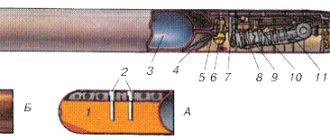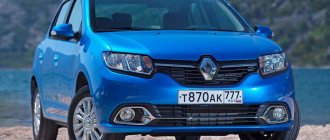One of the oldest brands
Volkswagen Golf itself has been produced since 1974 and is one of the oldest brands in the automotive business. Over the entire period of its existence, more than 35 million of these machines have rolled off the assembly line, seven generations have changed.
The new eighth-generation hatchback from the German automaker was announced on October 24, 2019, delighting its fans and admirers with yet another innovative solutions implemented in the “filling” of this car.
Salon
The interior of the 2021 Volkswagen Golf 8 was recently declassified and it is made in the best traditions of the company and it immediately becomes clear that this is the interior of a new era golf class. I wonder whether the new VW Polo 2021 for Russia will borrow much from the Golf?
The interior of the new VW Golf body in the basic configuration and with a manual transmission.
They clearly show two large displays, almost integrated with each other - central and acting as a digital instrument panel.
The automatic transmission will now have such a switch instead of the gear selector.
There is also a completely new multifunction steering wheel, a transmission selector in the form of a small joystick, and... touch-sensitive light control buttons! There are only five physical buttons on the panel, and all of them are located under the central display.
External differences between the Volkswagen Golf-8 and the 7th generation model
Like its predecessor, the Golf-8 is based on the MQB platform and has almost the same wheelbase (1 mm difference).
The new car is not much different from the previous version in the exterior (especially the side), many technical characteristics remain almost the same.
As before, the passenger car will not be offered in a three-door or convertible version; buyers will have to be content with only a five-door hatchback.
But in general, there are more than enough changes here, especially in the interior, and in the exterior appearance of the Golf-8 it is worth noting:
- narrower "double-cell" headlights with upper LED strips extending far into the front fenders;
- rear “stepped” lights with straight lines, previously they were more rounded;
- a narrowed radiator grille with a large round emblem along a sloping hood with pronounced lateral longitudinal edges;
- the total length increased by 26 mm with a decrease in height by 36 mm.
The new model has a top-end version of matrix headlights with 22 separate LEDs; such optics were previously available only on the Passat B8 and Touareg.
Thanks to all the improvements, the car itself has become more “fast” and stable on the road; the designers managed to achieve a reduction in the aerodynamic drag coefficient.
Although the new Golf looks similar to its predecessor, the body is completely different, and the body parts of the cars are not interchangeable.
Dates of appearance and price of Volkswagen Golf 8 in Ukraine
First information: the new Volkswagen Golf 8 will arrive in the summer of 2020. The planned price is also known - from $23 thousand: perhaps the “base” car will not receive several systems that are available in Europe, but will receive a 6-speed automatic transmission. Versions with “mechanics” are still in question, and similarly with the turbodiesel: I’m really looking forward to the latter – it’s good!
Taking into account the temporary handicap of six months, it is too early to say what Ukrainian buyers of the Volkswagen Golf 8 will receive: a full range of engines and gearboxes, configurations and equipment, a “bad roads” package, exact prices - all this will become known closer to the start of sales car. But one thing is already certain: the Volkswagen Golf 8 once again sets new standards for the segment; it is again the leader of the C-Class. I am sure that even in Ukraine, with all our love for crossovers and sedans, there will be many buyers for such a thoroughbred “European”.
Interior Golf-8
In the cabin, almost all controls have become touch-sensitive (with the exception of the emergency button), and the gearshift lever has been reduced to an incredibly small size. The same is implemented on the new Skoda Octavia A8.
The interior of the VW Golf 8 itself remains as laconic as before, thought out to the smallest details.
The multi-adjustable front seats with sliding base extensions are very comfortable and practical.
A good level of comfort is also provided by the rear sofa with a very high seating position for passengers.
The second row in the cabin cannot be called too spacious, but for this class of car it has quite acceptable performance.
Among the features of the salon space I would also like to note:
- steering column with a wide range of adjustments for reach and tilt;
- a fully touch-sensitive front lighting control unit located to the left of the steering wheel;
- optionally available Park Assist parking system, which allows you to park automatically, without driver intervention;
- large multimedia display with a diagonal size of 8 or 10 inches, depending on the configuration;
- the ability to connect software to the Internet with over-the-air updates;
- a new generation digital instrument cluster with expanded functionality;
- up to 32 interior lighting options.
At his discretion, the driver can display on the dashboard screen both a navigation map with widgets on the sides and familiar dials with analog scales.
There is three-zone climate control, controlled by the touch of your fingers from the multimedia screen, both coarse and more precise settings are available.
Data located in the operating system’s memory can be saved in cloud mode, then used in another car similar to the VW Golf-8 (for example, remembering the position of the seats, selecting interior lighting, air conditioning temperature settings, and so on).
Interior
The main innovation of the cabin is immediately visible - two screens directly in front of the driver. Now there are no physical devices.
Everything is customizable, the right screen has touch controls. This is where the control of almost all the car’s secondary systems, such as climate control and navigation, went.
For an additional fee, you can install a projection panel in front of the driver. This is a useful thing - at least my colleagues like it:
As in the Porsche 911, the automatic transmission selector has become more like a small joystick:
Trunk
The luggage compartment of the new Golf is practically no different from the trunk of a regular city hatchback:
- the door here is equipped with standard gas stops;
- the backrests of the rear sofa fold in a 60/40 ratio;
- there is a top shelf;
- there is a two-level false panel covering the niche for the spare tire;
- hooks for securing things, a backlight, and a 12V power socket are installed.
The luggage compartment volume of the car is 380 liters; with the backrests of the second row of seats folded down, it increases to 1237 liters.
Model history
The first Volkswagen Golf was modeled by automobile designer Giorgetto Giugiaro. Before its appearance, VAG head Heinrich Nordhoff relied on cars with rear-wheel drive and air-cooled engines. But over time, they began to be in less and less demand among consumers.
Therefore, in 1974, Volkswagen presented to the world community an excellent alternative to the Beetle - the 1st generation Volkswagen Golf. It was radically different from its predecessor by the presence of:
- front-wheel drive;
- water cooling;
- transversely mounted motor.
The technical solutions of the front-engine car were borrowed from Auto Union, and the design ones from NSU. The first Golf was equipped with engines from:
- Audi 50;
- Audi 80.
The new Volkswagen Golf model immediately became popular in the European market. At that time, car modifications, even with small engines, were considered sports. And since the oil crisis hit in the 1970s, the VW Golf 1 was at a premium with moderate appetites.
Conveyor production of the Golf lasted from 1974 to 2009. It was produced with different body options:
- 2-door convertible;
- 3- and 5-door hatchback;
- 4-door sedan.
The greatest demand was for hatchbacks, which were assembled at car factories not only in Germany, but also in Austria, South Africa, Mexico, the USA, and Yugoslavia. Between 1974 and 1983, VAG produced more than 6,000,000 cars, 1/6 of which were equipped with diesel engines.
It is worth noting that, along with the diesel Golf, the production of a “charged” hatchback, the Golf GTI, was launched in 1796. It was equipped with a high-performance engine producing 110 horses and a Bosch K-Jetronic mechanical injector.
Engines, suspension and transmission
Volkswagen has equipped the eighth generation Golf with a whole range of power units (13 possible options in total), including petrol and diesel internal combustion engines with a volume of 1.0 to 2.0 liters, hybrid units, and only pure battery versions are missing.
All internal combustion engines are turbocharged, with three or four cylinders, and there is also an option for an engine running on liquefied natural gas.
Europeans have access to Golfs with two types of 2.0 TDI diesel engines – 115 and 150 hp. s., and the base gasoline unit is a 1.0-liter 3-cylinder internal combustion engine with 89 horsepower (there is also a liter 110-horsepower engine).
One and a half liter engines are offered in 130- and 150-horsepower versions, “mild hybrids” eTSI – with a power of 110, 131 and 150, and eHybrid with plug-in drive – 204 and 245 hp. With.
The transmission is presented much more modestly - it is either a six-speed manual BVM6 gearbox or a DSG-7 robotic gearbox.
The Golf-8 hatchback, which is promised to be delivered to Russia no earlier than the fall of 2021, will most likely be supplied in only two versions - with a naturally-aspirated 1.6-liter engine producing 110 hp. With. and a 1.4-liter TSI engine with 150 horsepower. Estimated price from $22,000.
In all modifications, the German hatchback receives only front-wheel drive, McPherson suspension at the front, but the rear axle can be a torsion beam (in the budget version) or a multi-link type (in top versions).
The optionally available adaptive suspension control allows you to fine-tune the chassis to the road surface conditions, with driving modes “Economical”, “Comfortable” and “Sporty”.
VW Golf GTI VIII. New hot hatch for Russia
Russian dealers will soon have the 8th generation Volkswagen Golf. In Russia, this model does not pretend to be widespread, so Volkswagen decided to promote it as something special: they will only supply us with expensive versions. You will be offered a choice of a 150-horsepower modification in the top-end configuration and a 245-horsepower Golf GTI. We are especially looking forward to the latter, because there are practically no fast golf-class hatchbacks left on the Russian market. However, our colleagues from the British publication Autocar have already tried the new product and claim that the legendary spirit of the GTI has partly evaporated. Drom publishes a translation of their test drive, to which we added our comments about what other hot hatches can now be bought in Russia.
It took Wolfsburg very little time for the GTI to join the range of modifications of the 8th generation Golf, and this says a lot about how important the sports version is for the manufacturer and what a significant role it plays in the business performance of the entire Golf family.
Throughout its four decades of life, the Golf GTI featured discreet and sensible factory tuning, which helped it win the hearts of a wider audience than its hot hatchback rivals. And this brought Volkswagen good money. The simple truth is that every mass car manufacturer dreams of making a high-selling performance modification that is as successful as this one. Many have tried to repeat this recipe - and often failed.
And although one would expect that Volkswagen would be very careful in changing the proven recipe, we already know that the eighth iteration is not made according to the principle of “the same cabbage soup, but pour in thicker.” All the new touches that the Golf has received over the past generations have been done with delicate strokes. The fifth-generation “old man” was reborn into the slightly plump but recognizable Golf VI, and then into the slightly more polished Golf VII - but you could blink and not notice the generational change, which is quite forgivable.
The guys from Wolfsburg insist that the heart and soul of the GTI is still aimed at the average driver and everyday commuter, and the essence of this car is that, on the one hand, it excites the blood, but on the other hand, it remains a smart buy for the money. However, now they have clearly decided to take a chance on their goose that lays the golden eggs. The 8th generation hot hatch definitely tries hard to engage and entertain you, and it has more of that ambition than any of its ancestors.
The big question that comes to mind after a long day behind the wheel of a new car is: is this car still as enjoyable, versatile, practical and dynamically balanced as you'd expect it to be?
We have already driven pre-production copies and therefore are familiar with the technical changes that the car has undergone, and with its differences from the seven and a half generation Golf. In a nutshell, the car's mechanical underpinnings may look familiar, but just about everything here has been given a "overhaul."
The engine has some solutions inherited from the engine of the previous GTI Performance, but there is a new higher pressure injection system, and the combustion and emissions control systems have also been revised. Although there is the same choice of gearboxes - a 6-speed manual and a 7-speed robot with two clutches, the latter has received a new version, used for the first time on the Golf. There is no mechanical connection between the selector and the box itself (shift-by-wire technology). The electronic simulated differential lock XDS+, which was previously available as an option, is now included as standard, with the system now configured to be more active and able to more clearly influence the vehicle's handling.
It is now possible to get wheels with a diameter of up to 19 inches - larger than ever before on the Golf. There are low-profile 235 mm tires specially developed by Bridgestone. Adaptive DCC dampers remain an option, but they have been retuned to offer a wider range of adjustment and allow more precise control over the degree of softness and comfort or chassis grip and responsiveness.
In general, there are a lot of fresh decisions that need to be taken into account. But the main thing is that the deep retuning of the suspension and steering says a lot about the new priorities of the model - it has become “a little more racing.” The ground clearance is 15 mm less than that of a regular Golf. Compared to the outgoing GTI, the front springs are 5% stiffer and the rear springs are 15% stiffer. The rear suspension kinematics and mounting points have been revised to make the chassis more responsive and provide better control of wheel lateral movement. The variable-feel steering has become sharper by 5–7%.
According to Volkswagen, all this is done with a focus on better handling and responsiveness throughout the entire speed range, but especially in tight corners. The car should feel more balanced, agile and - whisper it languidly - playful. And he really makes a big impression. Now the GTI is a more vigorous and pumped-up device than its predecessors. He is much more eager to grind the asphalt and make lightning-fast maneuvers.
But the problem is... none of this is particularly in character with the GTI, is it? The car's dynamic talents (at least so far) weren't in how fast it could slalom at 18-meter intervals. During the time that I have been driving modern high-speed Golfs, their main advantage was that, for all their capabilities, they remained road cars with a pragmatic bent. These cars were built on the principle that being able to perform well on rough, wet secondary tracks is just as important as being able to improve your lap times on a race track by a couple of seconds. Or maybe the first and more important...
The new GTI is tightly built and sharpened, its character is more straightforward and lively than the old GTIs we knew, which were created according to the same, precise recipe. But the new one is also tougher, fussier and less refined. On the other hand, if you've always disliked the GTI, thinking its pragmatism ruined the whole fun, then the new product may be more tempting for you.
The car is still very recognizable from the driver's seat. The chair has a new design with an integrated headrest, but remains very comfortable. Well-sized side bolsters provide good lateral support. The signature “de rigueur” checkered fabric upholstery is in place, all controls are correctly located, except that the bulky manual gearbox lever and the overly plump steering wheel can be classified as minor “jambs”.
Perhaps touch controls for non-essential functions won't be to your taste. The steering wheel spokes are definitely overloaded, and it's easy to press a few extra buttons by mistake when turning the steering wheel. But I liked the digital devices, they are easy to read, the information can be configured in different ways. And for some reason I’m fascinated by this signature GTI honeycomb pattern in the background of the instruments.
The updated EA888 series 2.0-litre turbo engine still seems overly intelligent by hot hatch standards. It doesn't snarl or pop when you let off the throttle, doesn't roar or whistle under load, and is always willing to lower its voice to a subdued background rumble whenever you want it to. It's more powerful than you'd expect. The engine is ferocious, punchy and responsive from 2500 rpm. It doesn't have much to offer beyond 5,000 rpm, but you don't want to be constantly revving the engine to redline - the slightly slurred manual gearbox lever and heavy pedals aren't exactly conducive to this driving style. But if the tachometer needle dances between these two values, the Golf GTI will feel like a car with a lot of capabilities that shoots forward. It definitely grabs your attention.
There is a slightly obtrusive rigidity to the car's character, the shock absorbers seem uncompromisingly “bony”, and this also forces you to concentrate and may even distract you from everything else. When you find yourself on an uneven surface, you immediately want to find where the adaptive chassis mode turns on, which will add energy to the suspension. Her absence became noticeable.
I myself am surprised that I note such a shortcoming, and it should not be exaggerated too much. On most British roads the GTI handles reasonably well and is still better than most rivals. The rigidity of the suspension in the transverse direction leads to the fact that riders begin to shake their heads when asymmetric shocks come to the axles. The suspension also struggles to cope with large bumps, even when the 15-position slider responsible for adjusting the DCC active shock absorbers is moved to its lowest position (this is available when using the Individual mode). On highways with lots of patches, the body vibrates only slightly and is a little reluctant to stabilize. This is the work of the new, stiffer rear suspension, which has received different mounting points and settings. It also determined all the advantages in terms of handling.
So is it worth it? Well, to begin with, I spent almost the whole day behind the wheel, driving around towns, as well as along highways intended for everyday trips from point A to point B. And at first I did not feel any innovations. Yes, at low speeds the car has become a little more composed and sharp, but the handling character remains “linear” and not “hyperactive”, the car is still easy to handle and listens well to the controls. The faster I drove and the more carefully I listened to the sensations, the more obvious the characteristics of the chassis became - it quickly reacts to all the driver’s actions and is tenacious. But would this completely change the character of the car? It didn't seem that way to me. At first.
Then I went in search of the right road for the GTI - with bumps, pebbles, slopes, bends. Where the asphalt is either slippery or rough. And turns of all kinds. This is the only way to find out how many bumps the suspension can filter and “absorb”, allowing you to drive in the calm manner typical of a fast Golf. And to be honest, it turned out that this was not the car I was hoping to see. The car before me - for all its convincing speed, sharpness and stability - seems more like an ordinary modern hot hatch than the successor to the car that became an inimitable icon 44 years ago. A car that has earned the right to go its own way.
You will not be left indifferent by the power, cheerful disposition, good grip and speed of reactions of this car. However, it cannot be said that any of this was greatly lacking in the previous Golf GTI. Perhaps a new character is exactly what you want from a fast Golf. But if you previously liked the “matureness” and moderation that was characteristic of this model for many years, perhaps the new product is not for you.
All the mentioned innovations were implanted into the car, which in many respects retained its main advantages. This is a well-equipped, high-quality and functional transport for every day. Now there is a new “multimedia” with a touchscreen, customizable virtual instruments, a full set of security systems and the latest V2X communication developments (allowing the car to receive information about the road situation, etc. “on the fly” - translator’s note). Taking all this into account, the Golf has become a well-packaged representative of the technical avant-garde in its class. It's practical and overall as well put together as any previous Golf. Some argue that the latest generation offers a little less of the legendary "feel of quality", but if so, the difference is not so great that it is inferior to any of the competitors.
So, the car was given toughness, liveliness, character and aggression. The three letters on the rear door of this hot hatch have taken on a new meaning. Volkswagen tried to give us more arguments in favor of buying the GTI. But the thought haunts me: is it possible that there are fewer really good arguments? Before us is an animal of a new breed. And it will definitely take time to get used to it.
Specifications
Engine : 1984 cm³, 4-cyl., turbocharged, petrol Transmission : 6-speed manual transmission, front-wheel drive, electronic differential lock imitation Power : 245 hp Torque : 370 Nm Acceleration 0–100 km/h : 6.3 sec. Top speed : 250 km/h Curb weight : 1463 kg Fuel consumption : 5.3–8.6 l/100 km CO2 emissions : 169–174 g/km
Price : £33,460 (RUB 3,322,000)
Rivals : Hyundai i30 N , Ford Focus ST , Honda Civic Type R
Droma's comment: Russian prices for the 8th generation Golf have not yet been disclosed, but all the details of the equipment have already been published. The base version will be the 1.4 TSI (150 hp) with an 8-speed automatic transmission, which will be offered only in the Exclusive package. It includes matrix LED headlights, virtual instruments, three-zone climate control, a driver's seat with massage, a heated steering wheel, and 17-inch wheels.
The “charged” Golf GTI with a 2.0-liter turbo engine (245 hp) will be equipped exclusively with a DSG “robot”. The equipment is also very rich, complemented by sports seats. And for an additional fee you can get such elements of the “beautiful life” as a Harman/Kardon audio system, a panoramic roof and projection devices.
Previously, many similar fast hatchbacks were sold on our market - Ford Focus RS, Opel Astra OPC, Mazda 3 MPS, Renault Megane RS, Skoda Octavia RS. Each one was very interesting in their own way. Now, in fact, we are offered only one golf-class hot hatch - the Hyundai i30 N with a 2.0-liter turbo engine, which, depending on the degree of boost, develops 249 or 275 hp. The gearbox is only “mechanical”. The younger modification reaches “hundred” in 6.4 seconds and costs from 2,200,000 rubles. More powerful - 0.3 seconds faster and 150,000 rubles more expensive. It should be noted that although this is the first experience of Koreans in this genre, the i30 N turned out to be a real athlete. Details are in our material “Testing on a racing track: the only hot hatch in Russia on the track in Myachkovo.”
As an alternative, it makes sense to consider the Mini John Cooper Works with a 2.0-liter turbo engine (231 hp) and an automatic transmission, for which they ask from 2,300,000 rubles. Acceleration to 100 km/h is 6.1 seconds. You can save a little and take the weaker version of the Cooper S (192 hp), which costs from 1,925,000 rubles. The dynamics with the “mechanics” are 0.7 seconds worse, with the “robot” - by 0.6 seconds.
Kia has a near-sport modification of the Proceed in the GT ( 200 hp) and a DCT robot. In terms of dynamics, this car is much inferior to the above-mentioned ones: 7.5 seconds to “hundreds”. At the same time, the price is at the level of full-fledged hot hatches: from 2,184,900 rubles.
If money is not an issue, then you can pay attention to the extreme Mercedes A 35 AMG 4Matic (306 hp), which will cost 3,380,000 rubles. Its dynamics are truly sports car-like: 4.7 seconds to 100 km/h. This is faster than, for example, the base Porsche Cayman or Boxster (they take 5.1 seconds to accelerate).
Photobonus
Options
The new generation of Golf 8 will no longer have the traditional optional Trendline, Comfortline and Highline kits; they will be replaced by the following trim levels:
- Golf;
- Life;
- Style;
- R-Line.
The basic equipment of the Golf includes all-LED lights, R16 wheels, a digital instrument panel with a large screen, all kinds of driver assistants, such as keeping the car in its lane, automatic braking when there is an obstacle in front, Front Assist, etc.
Any of the modifications includes keyless entry and automatic three-zone climate control.
In general, the standard equipment of the new car has been significantly improved compared to the Golf-7.
The sports version of the R-Line is equipped with 17-inch Sebring wheel rims, special seats and bumpers, and has its own original interior.
There will be four trim levels available in the UK - S, SE, SEL and R-Line.
Exterior Design of VW Golf 8:
Volkswagen Golf 8
Even if the new Golf has not yet gone on sale, information about the design has long been leaked. How To Cars caught several pre-production cars that were barely camouflaged. Photos show that the shape and bodywork remain true to its basic form and predecessors. The headlights taper towards the grille and are expected to be retracted into the fender. The hood is very rounded towards the front grille.
In the new Golf 8: compared to its predecessor, Volkswagen has done a lot. The headlights (standard LED) are much thinner and protrude slightly onto the fenders. The hood is contoured and lowered, the grille is narrower. A continuous chrome strip optically connects the headlights. At first glance, the Golf resembles one of the Polo's younger brothers.
The mirrors are also more rounded than their predecessor. At the rear you can see parallels with the T-Roc. The taillights look like a cross between the current Golf and a compact SUV.
In the front part, the air intakes are reduced, the turn signals stick out like eyebrows into the wings. All the proportions, including the rear end, look familiar - it's no surprise that the new Golf 8 is based on a single, slightly modified 'MQB Evo' platform from existing models.
However, the key element of the Golf remains the pronounced C-pillar. Particularly proud is the more pronounced rear end, which should give the Golf 8 a more attractive appearance despite the same wheelbase width. The two-piece LED taillights are new, with reflectors positioned higher on the Golf 8.
Volkswagen Golf 8
A slight disappointment: the new Golf has artificial tailpipes. The actual exhaust ends before the rear apron.
Volkswagen Golf 8
The dimensions remain almost identical:
In terms of size, the Golf stays true to its predecessor's dimensions and doesn't get too big. At exactly 4284 millimeters, it is two inches longer than its predecessor with 4255 millimeters, and remains virtually unchanged in width (from 1789 millimeters to 1799 millimeters previously). The height of the Golf 8 increases minimally: from 1456 to 1452 mm, and the wheelbase is almost identical from 2636 to 2637 mm.
New features of Volkswagen Golf
One of the new functions of the new Golf, designated as Travel Assist, will allow you to fully control traffic at speeds of up to 210 km/h, using adaptive cruise control, Lane Assist, and keeping the car in the road lane. This mode can be activated using the steering wheel controls.
The Golf also has the latest version of the VW MIB3 infotainment system, which supports not only touch but also voice control.
The system is constantly connected to the Internet via eSIM, uses Amazon Alexa, provides music streaming, provides information about purchases and traffic, and can be updated wirelessly.
I would like to note that the Golf-8 is the first Volkswagen car with Car2X communication, which allows you to exchange data within a radius of up to 800 meters with other vehicles that have the same connection.
Drivers will be able to warn each other about possible dangers, traffic jams, emergency situations, and so on.
VW Golf 8 interior: new head-up display:
Volkswagen Golf 8 multimedia
To continue to offer sufficient sales incentives and develop Golf in the digital age, Volkswagen has announced a revolution in the interior. First of all, the new Mercedes A-Class with its huge screen showed that changes in the automotive industry are now moving rapidly. The Golf therefore gets a large multi-display that extends from the left A-pillar to the front passenger.
Volkswagen Golf 8 saloon
Let's start with the front: The seating area is pleasantly deep and all-round visibility is good.
When Volkswagen showed off the prospect of the next generation Modular Infotainment Suite (MIB) at CES in Las Vegas in early 2021, it was clear that Volkswagen had made significant changes to the interior. Depending on the equipment level, many functions of different types and sizes are integrated - the prototype is the new Touareg. In the photo it is easy to see that the head-up display grows to incredible sizes and occupies almost the entire space in front of the windshield.
What attracts attention is of course the digital cockpit with a 10.25-inch display (26.04 centimeters diagonal) that represents the Golf 8 series. Together with the large “Discover Pro” navigation system, this combination results in the so-called “innovative cockpit”.
In addition, the interior of the new Golf has been designed to be pleasantly slimmed down. There are hardly any buttons or switches, with most functions controlled either through the standard multifunction steering wheel (there are a lot of buttons), voice control or touch controls. Speaking of controls, the classic rotary dial is eliminated, with functions controlled by touch surfaces to the left of the steering wheel. If you leave the setting at Auto, you don't have to worry.
Volkswagen Golf 8
Some versions of the Golf 8 have a tiny 'shift knob'. better quality than the ID.3.
MIB 3 has been further developed for the Golf 8:
Volkswagen talks about "the smartest Golf than ever." Unsurprisingly, the eighth generation is the newest and should be especially modern. At the presentation, VW explains in detail that all infotainment systems are connected to a so-called “online communication module” equipped with a permanently installed SIM card. This means: the new Golf 8 is always online.
"We Connect" includes features such as mobile key (can only be used with Samsung smartphones), emergency call, vehicle status and more, and can be used indefinitely. The We Connect Plus package offers the following additional features: Zone or Speed Alert, Online Parking Heat (where available), Online Traffic Information Plus, Online Voice Control, Wi-Fi Hotspot and Service "We deliver."
Volkswagen Golf 8
If you want an integrated navigation system, order the Discover Pro system with a 10.25-inch touchscreen (26.04 centimeters diagonal). VW calls this dual system an "innovation cabin" - reminiscent of Mercedes' MBUX presentation.
Volkswagen Golf 8
If you don't like the pre-installed package, you can completely customize the individual settings. Just touch and hold the icon or move it to any position. The graphic is simplified in golf.
Smart Settings: Temperature and volume settings can be set easily and quickly using so-called slider touch surfaces, so you don't have to go to submenus. Double-tapping the touch surface activates the seat heating method, which also comes on very quickly. In addition, four shortcut buttons are located around the hazard warning button. This allows direct control of the assistance system, driving modes, climate settings or parking sensors.
The touchscreen main menu has a Home button on the left side from where you can return to the main menu at any time. Anyone who now thinks that the Golf 8 and ID.3 share an infotainment system is mistaken: the optics and control logic may be similar, but technically the systems should show significant differences.
VW relies on voice control:
In voice control, VW wants to keep pace with the Mercedes A-Class - and even overtake it. All functions of the future Golf can be controlled using the touch screen and voice control, without interfering with driving. There are many free voice commands, for example: “I’m tired”, enough to direct the car to a nearby hotel. In addition, the system can provide a route on demand (“Why, VW, did you suggest this gas station?” - “This gas station is on a direct route”). Thanks to artificial intelligence, software must constantly learn and interpret freely spoken sentences better and better. Over time, the system should get to know the user and his preferences better and use this knowledge to make personalized route suggestions. Like Mercedes, Volkswagen also wants to write the software itself - despite all the euphoria of the digital revolution, Volkswagen does not want to risk relying on Amazon, Google or Apple.
Even with voice control, VW has improved to always be ahead of the competition. Using “Hello Volkswagen”, intelligent voice control is carried out, for example, you can set: climate, destination and other functions. In the first short test, voice control functioned quickly and reliably. Amazon Alexa is optionally integrated directly into the Golf - so you can request news, play music or any smart home device, conveniently controlled from inside the car.
The system works like a smartphone:
If the driver logs into his Golf using his Volkswagen User ID on his mobile phone, the system accepts preconfigured settings for the seats and ambient lighting. As with the Apple ID, apps for streaming services (watch videos) or navigation can also be downloaded from online sources.
If necessary, the menu can also be highlighted or displayed on the entire screen, but it can also be displayed in the background. For example, if you navigate using navigation, you can still open the menu for phone calls in a small window - after this, the menu disappears into the background without disappearing completely.
Sales starts, updates
Although the 2021 Golf has been officially unveiled but is not yet on sale, it is expected to arrive at European dealers in December 2021.
There is also unverified information that the model will arrive in Russia with significantly reduced functionality, and in the USA, primarily sporty versions of the GTI and R are expected.
In the UK, sales of the Golf 8 hatchback are scheduled for spring 2021, with an estimated starting price of £20,000.
All sports modifications (R, GTI and GTD) will receive updates and will also be produced in a new generation and will appear on the market in the middle or end of next year.
But the e-Golf electric car based on the Golf 7 will cease to exist, it will be replaced by the new VW ID.3 model.
Hybrid and non-hybrid
Since we don’t have any of our cars, I take the option closest in power – 150 horsepower with DSG. And not just a simple one, but with a small letter “e” in front of the TSI nameplate. This is a mild hybrid, in the depths of which a 48-volt battery and a starter-generator are hidden. The electronic filling allows you to save a couple of liters of fuel per month. Isn't it a significant contribution to reducing environmental pollution? But such cars have access to an adaptive DCC chassis, which allows you to change the power steering settings and shock absorber characteristics.
The new body is 36 mm lower. Panels made of high-strength steel are marked in yellow, panels made of especially high-strength steel are marked in red. The drag coefficient has been reduced from 0.300 to 0.275.
The new body is 36 mm lower. Panels made of high-strength steel are marked in yellow, panels made of especially high-strength steel are marked in red. The drag coefficient has been reduced from 0.300 to 0.275.
Fifteen hundred turbo powers are invigorating, but there are still slight pauses in gearbox shifts and responses to the gas pedal. This is treated with the “sport” mode: the weight on the steering wheel increases, the shock absorbers tighten... and all the imperfections of the road are transmitted to the cabin. It’s better to choose the “individual” mode: you can remove the pedal damping, but keep the standard chassis settings. In this version, the Golf delicately writes an arc and, with German meticulousness, generates ideal feedback, without shaking out the soul. But the whole way the feeling of artificiality does not leave me. It's like you're driving a large sedan rather than a compact hatch. Is it due to the heavy battery?
The chassis architecture has not changed - the Golf is based on the MQB platform. From now on, versions with 1.5 TSI can be supplemented with a 48-volt battery and a starter-generator.
The chassis architecture has not changed - the Golf is based on the MQB platform. From now on, versions with 1.5 TSI can be supplemented with a 48-volt battery and a starter-generator.
The rechargeable hybrid is interesting to us primarily because it uses the same engine that will be supplied to Russia - a 1.4-liter TSI with a power of 150 hp.
The rechargeable hybrid is interesting to us primarily because it uses the same engine that will be supplied to Russia - a 1.4-liter TSI with a power of 150 hp.
For an answer, I jumped into a 130-horsepower non-hybrid. With a manual transmission, a simple chassis and a beam at the rear instead of a multi-link. How I looked into the water! The two liters of fuel saved per month are not worth denying yourself this pleasure: an honest, understandable car! It is inferior in dynamics to a 150-horsepower mild hybrid, but it drives correctly and easily! The same intelligentsia at the helm. After it, I want to wait even more for our Russified version with simple gasoline engines.
Maybe the soundproofing will be completed? Otherwise, the tires make an outrageous noise against the backdrop of a delicately insulated engine compartment and polished aerodynamics.
Volkswagen Golf VIII
Volkswagen Golf VIII
Pros and cons of the first Volkswagen Golf model
Currently, purchasing a VW Golf 1 in technically good condition is not easy. But the new car had many advantages:
- economical fuel consumption;
- low cost;
- excellent build quality;
- cheap spare parts;
- ease of care;
- spacious salon.
At the time, the Golf I had few downsides. Most drivers were not satisfied with: low-power engines, lack of a tachometer, and unaesthetic design of the dashboard.
New cars rarely broke down. As a rule, after 100,000 km, the bearings of the stabilizer struts and the silent blocks of the rear beam failed. The car was made from high-quality steel, so it was not afraid of the “red disease”.
Engine
The C-segment car was equipped with both diesel and gasoline power units. Their range was presented:
- petrol engines 1.1-1.8 l with a power of 37-82 kW;
- diesel engines 1.5-1.6 liters with a power of 36-51 kW.
Read also Technical characteristics of Volkswagen Transporter T4
Golf with engines up to 1.5 liters debuted in 1974, but a couple of years later the presentation of a “charged” version with a 1.6 liter engine took place. Much later, the range of power units expanded. In 1982, hatchbacks began to be equipped with 1.8-liter “hearts”.










